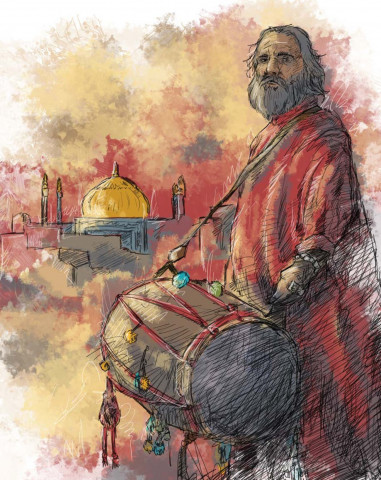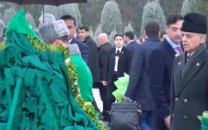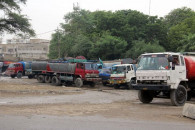To the beat of one hundred drums

The small town of Sehwan Sharif, located to the north-west of Hyderabad, is jolted awake for these three days in which at least half a million people flock to the shrine from all over Pakistan.
Swaying with emotion and dancing to the intoxicating beat of drums, hundreds of devotees perform the dhamaal, a devotional dance performed to the beat of a percussion instrument called the Naghara. Dervishes clad in long robes, beads, bracelets and coloured headbands twirl faster and faster in a hypnotic trance to the music of bells, gongs, cymbals and horns until, with a final deafening scream they run wildly through the doors of the shrine to the courtyard beyond.
The dance is not just a means to express one’s love and reverence for the saint but also a way to thank him for wishes that come true. “I have promised Lal Shahbaz that if my son comes back, I will come here to perform the dhamaal,” said Abida, one of the devotees at the shrine. Her son vanished without a trace 10 years ago and Abida was hopeful that if she kept praying for his intercession, her son would come back. “I have been coming here for the past three to four days, asking Qalander that I may get to see my son again,” she said.
Celebrations
This year the urs was inaugurated by Auqaf minister Abdul Haseeb Khan. Earlier on, the Sindh governor was scheduled to perform the first rites by placing a chador on the grave of Lal Shahbaz Qalandar but the governor was unable to come to Sehwan due to security risks.
It is estimated that more than 150,000 pilgrims will visit the shrine in the three days of the urs with at least 100,000 people coming to the shrine on the first day alone. Ministers, MPAs and MNAs are also expected to join the celebrations. Most people choose to present rose garlands and a green chador inscribed with Quranic verses in silver and gold thread.
An industrial exhibition will also be held on the sidelines of the urs and the traditional game of malakhra will be played. A literature conference will also be held and scholars and writers from all over Sindh are expected to participate.
Security preparations, living arrangements
Keeping in mind the sensitive law and order situation, especially after the bomb blast at Data Ganj Bakhsh in Lahore, around 6,500 policemen have been deployed around the shrine whose perimeters have been divided into six security zones.
Heavy vehicles have been banned from entering the premises of the shrine. Walk-through gates have been fixed at all entry and exit points with policemen and women performing thorough body checks before any of the devotees are let in. Since many of the devotees at the urs come from the Punjab, the government had earlier announced that a special train would be arranged from Punjab to Sehwan Sharif. The government wasn’t able to follow through on this promise. Many of these visitors from the Punjab stay at camps.
The trains that did make it, were put through extra security. Bomb disposal squads checked all passenger trains passing through Hyderabad, Nawabshah and other railway stations to Sehwan. A large number of pilgrims reached Sehwan on passenger coaches, vans, buses and personal vehicles.
Saint Shahbaz Qalander
Lal Shahbaz Qalandar, whose real name was Syed Muhammad Usman, was born in 1177 AD in Marwand, Iran. He reportedly stayed in Sehwan for six years and is believed to have performed several miracles. He died at the age of 97.
Published in The Express Tribune, August 1st, 2010.



















COMMENTS
Comments are moderated and generally will be posted if they are on-topic and not abusive.
For more information, please see our Comments FAQ